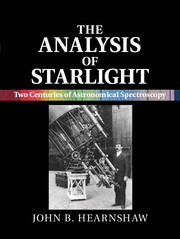Book contents
- Frontmatter
- Contents
- Preface to the second edition
- Preface to the first edition, 1986
- Acknowledgements
- 1 Introduction to spectroscopy, spectroscopes and spectrographs
- 2 The analysis of sunlight: the earliest pioneers
- 3 The foundations of spectral analysis: from Fraunhofer to Kirchhoff
- 4 Early pioneers in stellar spectroscopy
- 5 Spectral classification at Harvard
- 6 The Doppler effect
- 7 The interpretation of stellar spectra and the birth of astrophysics
- 8 Spectral classification: From the Henry Draper Catalogue to the MK system and beyond
- 9 Spectroscopy of peculiar stars
- 10 Quantitative analysis of stellar spectra
- 11 Some miscellaneous topics in stellar spectroscopy: individual stars of note, stellar chromospheres, interstellar lines and ultraviolet spectroscopy from space
- Figure sources and acknowledgements
- Appendix A List of solar lines designated by letters by Fraunhofer and others
- Appendix B Vogel's first spectral classification scheme of 1874
- Index of names
- Index of star names
- Index of spectral lines
- Index of subjects
- References
9 - Spectroscopy of peculiar stars
Published online by Cambridge University Press: 05 April 2014
- Frontmatter
- Contents
- Preface to the second edition
- Preface to the first edition, 1986
- Acknowledgements
- 1 Introduction to spectroscopy, spectroscopes and spectrographs
- 2 The analysis of sunlight: the earliest pioneers
- 3 The foundations of spectral analysis: from Fraunhofer to Kirchhoff
- 4 Early pioneers in stellar spectroscopy
- 5 Spectral classification at Harvard
- 6 The Doppler effect
- 7 The interpretation of stellar spectra and the birth of astrophysics
- 8 Spectral classification: From the Henry Draper Catalogue to the MK system and beyond
- 9 Spectroscopy of peculiar stars
- 10 Quantitative analysis of stellar spectra
- 11 Some miscellaneous topics in stellar spectroscopy: individual stars of note, stellar chromospheres, interstellar lines and ultraviolet spectroscopy from space
- Figure sources and acknowledgements
- Appendix A List of solar lines designated by letters by Fraunhofer and others
- Appendix B Vogel's first spectral classification scheme of 1874
- Index of names
- Index of star names
- Index of spectral lines
- Index of subjects
- References
Summary
Introduction to peculiar stars
The study of peculiar stellar spectra has always played an important role in stellar spectroscopy, ever since emissionline stars such as γ Cas, T CrB and the Wolf–Rayet stars were first recognized during the 1860s as being unusual (see Chapter 4).
Thirteen types of peculiar star are discussed in this chapter. In general, the peculiarities are either the presence of emission lines in the spectra, or the presence of absorption lines of abnormal strength or profile. These peculiarities often aggravate attempts to classify stellar spectra in a two-dimensional scheme such as the MK system, described in the previous chapter. This is especially so if the peculiarities are due to photospheric abundance abnormalities which result in either unusually strong or weak absorption lines.
The list of types of star having peculiar spectra is certainly not exhaustive; emphasis is given to discussing those in which the spectral peculiarities predominate or were the first observed. Other peculiarities, such as intrinsic light variability or those arising from the star being a binary, may also be present in many of these types. However a full discussion of the peculiarities in the spectra of all known types of variable or binary star is omitted for want of space.
Carlyle Beals and the Wolf – Rayet classification
By 1928 the problem of how to classify the absorption-line spectra of O stars had been essentially settled by the IAU Commission 29.
- Type
- Chapter
- Information
- The Analysis of StarlightTwo Centuries of Astronomical Spectroscopy, pp. 193 - 252Publisher: Cambridge University PressPrint publication year: 2014

